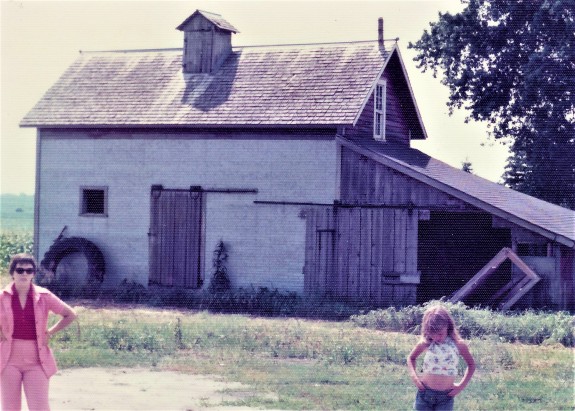October 14th…“SHARE A STORY ABOUT HARVEST TIME WITH YOUR FATHER ON YOUR MINNESOTA FARM.”

That Granary building on our farm was like a giant oatmeal cookie just waiting to happen! 😉 At least that’s one fun way to describe the crop that was stored inside that centennial, two-story wooden repository. I’m told that this building of purpose was one of the first and therefore the oldest structures built by the pioneer family who homesteaded this acreage in the 1800’s. Attached to the Granary, was an “L-shaped”, wrap-around machine shed on the north and west flanks of this structure. That was the place of protection for our father’s alfalfa baling machine and also may have been the storage for a grain harvester called a “combine” (which cut and processed the oat plants) that has something to do with today’s story.

It is a well-known fact that many millions of kids and adults enjoy their “Cheerios” breakfast cereal each morning. “Cheerios” are made from oats, just like the crop that our father, Russell, grew on our farm. So, for our family, I guess you could say that, instead of just “Cheerios” we also had CHEERY COWS cause they loved their grains, too! Oats, corn and other grains helped to grow our herd of Holstein dairy cows to be plump and healthy. A bovine, with a good appetite, can eat as much as 27 pounds of grain per day. With that need in mind, it’s no wonder our farmer dad had to harvest and store away as much grain as he could in the fall for the coming cold winter months. With an abundance of grain held in storage, Dad would be able to properly feed the ravenous cravings of our various livestock. Animals, just like you and me as humans, enjoy a good meal every morning and evening (besides them munching on grass in the pasture all day during spring and summer).

The rising sun, that day, was just as golden as our oat fields as it sparkled up out of the eastern sky. Dad had serviced and gassed up our tractors, gathered grain wagons and even a device called a grain auger to help ‘elevate’ the oats up into their new storage home after being harvested out in our fields. I recall at least a few extra helpers at the farm, on days like this, to assist with the harvesting operation. Sometimes, our dad hired local folk, and other times, family and/or neighbors came by to ‘give a hand’ of love and sweaty labor to get this job done before winter was once again upon us. Dad, in his good Christian upbringing, would always repay the kindness of those neighbors by making himself available to help them when a harvest time was happening at their nearby farms.

Sometimes, work and pleasure could be happily mingled. Like the time our Colorado cousins arrived at our farm just as Dad was airing up the grain wagon tires in preparation for the harvest about to commence. A grain wagon full of oats could weigh up to two tons (4,000 pounds), so those tires had to be in good condition and fully inflated to safely haul that golden load in from the fields.

As our trustworthy Farmall tractors began to pull the first loads of grain into our farm yard, our father already had a grain auger positioned and lifted up to the high swinging door at the top of our Granary roof-line. At the top, the funnel apparatus of the auger was then placed inside that small doorway and secured. This auger machine resembled a long, metal tube. Inside that metal tube was a very long, corkscrew shaft with cylindrical ‘spiral wheels’ that ‘filled’ that tube. Connected to the base of that metal tube contraption was a hinged metal basket called the grain hopper. A tractor would pull its wagon of oats just past the grain hopper and stop. The hopper, on its hinges, was then let down behind the wagon and a door on the wagon was pulled open to allow oats to begin filling the grain hopper. When the auger machine was energized, by a large electric motor (or otherwise), the corkscrew ‘wheels’ now began to turn round and round to send the oats up, up, up ….through the tube and out the funnel device at the top and down into the Granary itself.

Dad chose to enlist my young muscles that day to help him in this important farming event. I was honored and happy to help. It made me feel ‘grown up’ to be considered worthy to assist and no longer be relegated to just being a too-young bystander to life there on the farm. I found this experience to be a good bonding time, too, between my father, Russell, and myself. Besides, like Dad would say, “For every shovel full you take, that’s one I don’t have to make!” 😉 We were a team that day. Farmers in in the same ‘harness’ together.

Our family’s Granary was composed of two large rooms downstairs, and two upstairs. The doorways of each room had wooden tracking on each side in which boards could be slid down, one at a time, to close those doorways off as each granary room filled with grain. The second story rooms of the granary had a large rectangular opening in the center of the floor. As the grain came in from the grain auger, a funnel ‘sock’ would be aimed at that floor opening to allow grain to go below to fill the bottom room first. When the bottom room was filled, a rectangular ‘door’ was placed in the opening of the floor so that the upper grain rooms could now be filled to the roof, almost, with subsequent wagon loads of more oats.

As we two fellow Norwegian farmers entered the Granary that day, I vividly recall the fragrant and rich aroma of the oats filling our wooden ark that would keep our animals alive during the ‘flood’ of winter that would soon be here. To protect our lungs from at least some of the heavy oat dust flying everywhere, my father took one of his large, red bandanna handkerchiefs and, after wetting it, tied it around my head to cover my nose and mouth as a form of a dust filter. He then did the same for himself. Though the bandanna procedure was necessary, I thought it also a bit comical how Dad and I now looked like two cowboy bank robbers from The Old Wild, Wild West days!! 😉
Up the Granary stairs we climbed to the second-story rooms to help guide the grain that was soon to arrive from the auger. Once settled upstairs with our grain shovels in hand, Dad would give a shout or a loud whistle to a worker below who would start the long-reaching grain auger running. Dad and I shoveled furiously as we sent the incoming oats off into the corners of each upper room so that we could pack the building as full as possible with this golden harvest. The auger funnel above us continually poured dry ‘rivers’ of grain inside from the wagons down below that disgorged themselves of their amber cargo. As I shoveled grain diligently, in that upper Granary room, the sunlight came through the window and was doubly amber from the thick dust of the oats falling all around us as the grain filled the room. That lighted shaft of oat dust was so thick, I could barely see my father across that small room as we worked.

In comparison to today’s giant farming practices, our Granary was quite tiny. Yet, for us, it was the means to an end of caring for all the animals on our farm who loved a good meal throughout the year, especially in the frigid winter when the world around us was dead cold and covered in snow.

As I look back, my job that day was a small part for a small boy to do. Yet, it was still a part of the success of that day’s needs on our farm there in beautiful southern Minnesota. I had felt very close to my Dad that day in our teamwork up there in those dust-choked grain rooms and it made me proud to be a Norwegian Farmer’s Son.

You are an amazing story teller! Keep up the wonderful stories , I love them!
LikeLiked by 1 person
Awwwww, such a sweet and kind soul you are, Jacquie!!!! Bless you for this “million dollar” sharing! Means SO MUCH to know you care and enjoy the scratchings of this wannabe writer as I share heart and memories here!!! Hugs always!!! ;o)
LikeLike